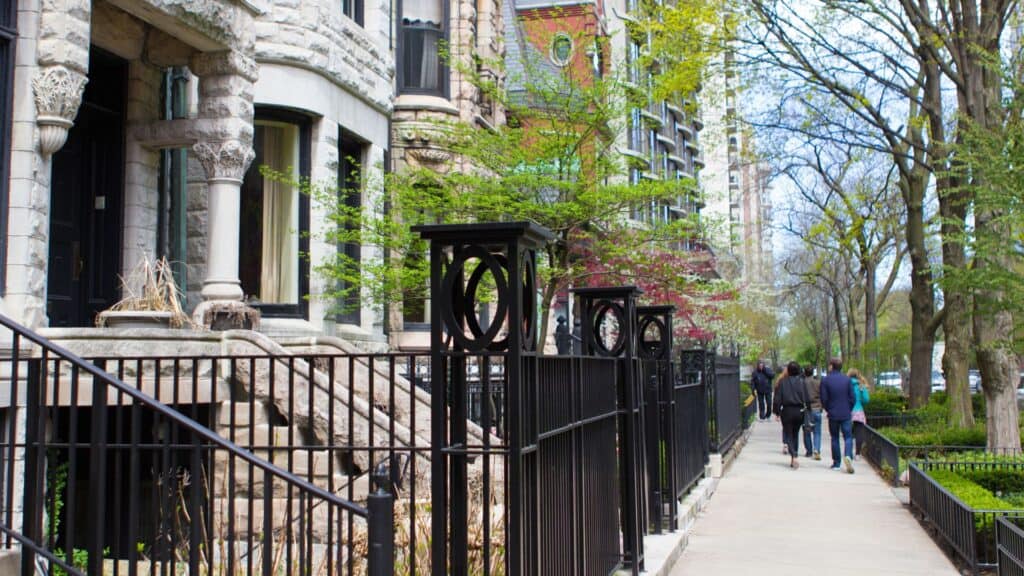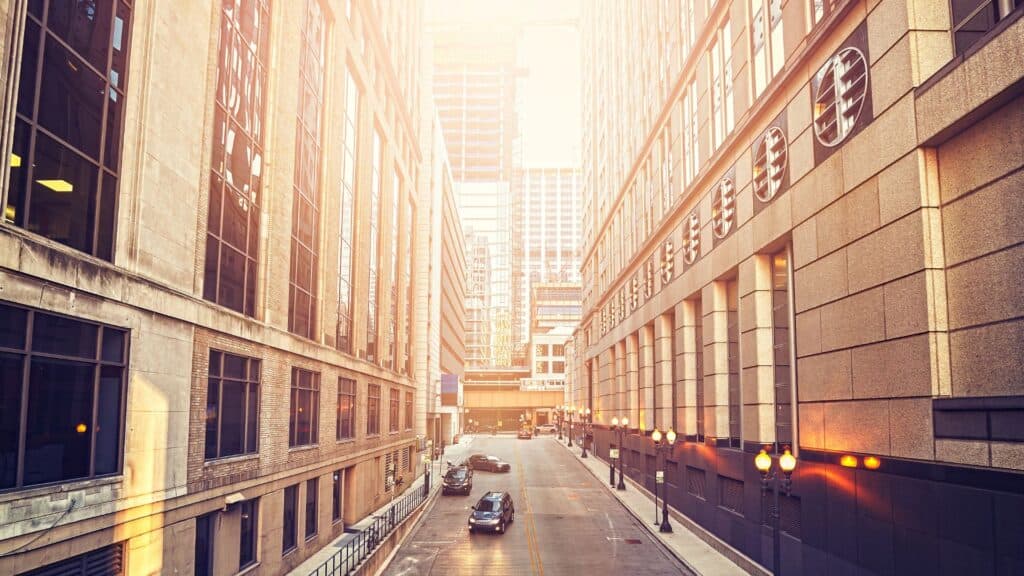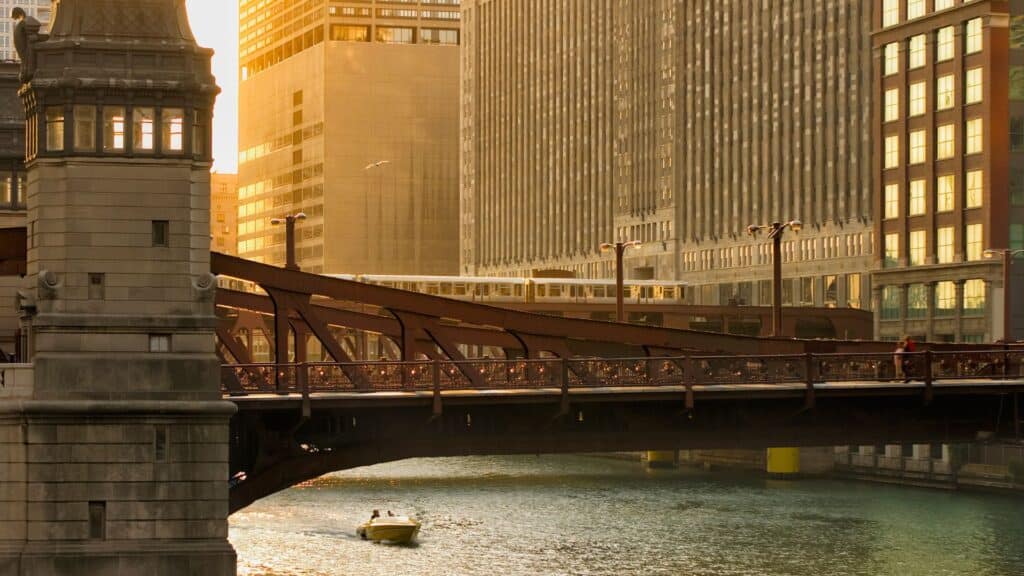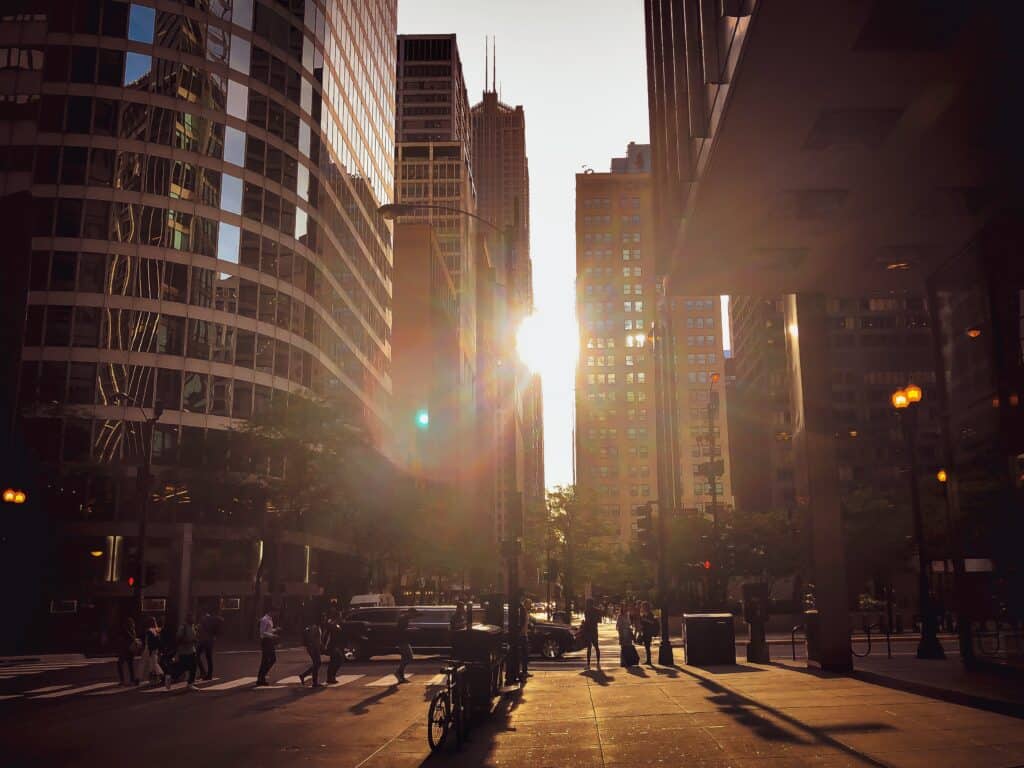The Bank of America Chicago Marathon is not just any marathon – it’s a legendary event that takes you on a journey through the vibrant streets of one of America’s most iconic cities.
The Chicago Marathon is well-known for its flat and fast course. It begins and finishes in Grant Park, guiding you through the breathtaking city views of lovely Chicago. This course has even witnessed four world records, numerous national records, and many personal bests achieved by runners.
As you run across 29 different neighborhoods of Chicago, you’re cheered on by a whopping 1.7 million spectators.
So, if you’re gearing up to take on this epic race, understanding the Chicago Marathon route is essential for a successful and enjoyable experience.
From the starting line to the finish, here’s everything you need to know about this incredible course.

Related: How To Enter The Chicago Marathon: Cost, How, and Who Can
Chicago Marathon Course Overview
The Chicago Marathon Route is an exciting and rewarding journey covering 26.2 miles (42.2 km). It starts and ends at one of the most iconic sites in Chicago – Grant Park.
A big part of the route is nice and flat, and since race mornings usually start off cool, it might be really tempting to start off fast.
But here’s the thing: even if you feel super energetic, remember that a full marathon covers 26.2 miles (42.2km), which is a pretty long distance. That’s why it’s smart to pace yourself right from the beginning, so you don’t run out of steam before the finish line.
As you step into your assigned starting area, get ready for a breathtaking view of the Chicago skyline. Among all those tall buildings, you won’t miss the Willis Tower, standing at a whopping 1,729 feet (527m) as America’s second-tallest building.
While you run your way through the Windy City’s 26.2 miles (42.2 km), you’ll see this famous landmark several times, and it will become a sight to look forward to, especially when you’re giving it your all in the final 5K (3.1 miles) push to the finish line.
In the initial miles of the race, the route guides you through the heart of downtown Chicago.
You’ll pass under Frank Gehry’s distinctive BP Bridge and proceed along State Street, which locals recognize as one of the significant north-south thoroughfares in the loop.
As you approach the 5-mile (8-km) mark, Lincoln Park greets you, and even Beatles fans might find a boost from a Fab Four cover band here.
After making your way through Lakeview, the course takes a southward turn, leading you back toward the Willis Tower. Running through Wrigleyville comes next, where energetic crowds, well-practiced in cheering for the neighborhood’s beloved Cubs, offer enthusiastic support.
As you reach approximately miles 8 (12.9 km) and 9 (14.5 km), you’ll find yourself in Boystown, a neighborhood known for its vibrant nightlife. On race day, Boystown transforms into an energetic cheer zone, offering you a boost of encouragement in the early morning hours.
Keep an eye out for the Righteously Outrageous Twirling Corps, a remarkable group of baton twirlers who are sure to leave a memorable impression.
Continuing your journey, you’ll head southward through Old Town and River North. As you run alongside the base of the renowned skyscraper, take a moment to look up and appreciate its towering presence.
As you reach the midpoint of the race, you’ll come to a point where you’ll cross the Chicago River while moving in a westward direction.
Not far from there, you might catch a delightful aroma of chocolate filling the air—an enticing yet slightly bittersweet distraction as you approach the 15-mile (24.1-km) mark.
After passing by the famous Illinois Institute of Technology designed by Mies van der Rohe, you’ll sense the finish line getting closer as you make your way back in an eastward direction.
Once more, remember to look up and spot the Willis Tower in the distance; the next time it comes into view, you’ll be entering the final stretch toward the finish line.
As you pass through Chicago’s Greek and Chinese neighborhoods, you’ll arrive in Pilsen, a Latino community.
The vibrant music might make you want to pause for a tasty taco, but the last miles of the course call you forward as you journey through the South Side.
The final stretch of the course guides you through the South Side. You’ll know you’re on track when you enter the neighborhood of Chinatown.
Passing through a traditional gate, you might find inspiration from the lively drum group to increase your pace a bit (if you’ve been pacing yourself well and feel up to it). Keep in mind that if it’s sunny, this section can be challenging, so be ready to tap into your inner strength.
Find out here, how to pace the perfect marathon.
Just past mile 23 (37 km), you’ll finally make the turn back north towards the finish.
Keep an eye out for the Willis Tower! Sometimes, you might face a headwind in this section, and the tall buildings along Michigan Avenue (starting around mile 24/38.6 km) could cause your GPS watch signal to act up.
But don’t worry, you’re really close now.
Beyond the 26-mile (41.8-km) mark, a right turn awaits, leading you to the only hill on the course: a railroad overpass. On any other day, you might hardly notice this elevation change, but after 26 miles (41.8 km), it might leave you a bit grumpy for a few moments.
Once you make a left turn, the finish line will come into view.
Go ahead and claim your well-deserved medal and the Goose Island beer that’s part of your entry fee—you’ve truly earned them!
Related: Chicago Marathon: How Long Should Your Longest Long Run Be
Chicago Marathon Course Map
Chicago Marathon Elevation Chart

The course’s elevation is approximately 600 feet (182,9m) above sea level, with a net gain of only 243 feet (74.1m). The absence of significant hills and the presence of long, straight stretches make it easier to establish and maintain a consistent pace.
As you turn right from Michigan Avenue onto a Roosevelt Road bridge over a railyard, you’ll encounter this climb.
After reaching the top, a left turn onto Columbus Drive awaits, leading you downhill for about 300m (984 feet) to the triumphant finish line.
Now that you have an idea of what awaits you in Chicago, here’s more of what you should expect along the Chicago Marathon Route.

What You’ll Find At Aid Stations
Throughout the Chicago Marathon course, you will find a total of 20 strategically placed aid stations, thoughtfully positioned approximately one to two miles (1.6-3.2 km) apart.
These aid stations are vital pit stops where you can replenish yourself. Each aid station follows a specific sequence, ensuring that your needs are met effectively:
- Medical Tent with access to a Runner Transport Vehicle
- Toilet facilities
- Gatorade Endurance Formula (lemon-lime flavor)
- Public address announcer
- Water
Medical Tent and Runner Transport:
As a priority, each aid station features a dedicated Medical Tent, equipped with professionals and access to a Runner Transport vehicle.
This service is available for non-emergency situations and provides transportation back to Grant Park if you’re unable to complete the race.
Toilet Facilities:
Convenient toilet facilities are available to ensure your comfort and convenience along the course.
Gatorade Endurance Formula:
Rehydration is essential, and the aid stations offer Gatorade Endurance Formula in a refreshing lemon-lime flavor to keep you fueled and hydrated.
Public Address Announcer:
Staying informed is crucial, and at each aid station, a public address announcer keeps you updated with vital information and race updates.
Water:
Fresh and cool water is available to quench your thirst and keep you going strong.
Additionally, for those seeking extra energy boosts, Gatorade Endurance Energy Gels are provided at Aid Stations 10 (Mile 13.6/21.9km) and Aid Station 14 (Mile 18.2/29.3km). These gels come in three flavors: Strawberry (caffeinated), Vanilla (non-caffeinated), and Mango (non-caffeinated).
During the stretch from Aid Stations 15 to 18 (Miles 19.5-23.5/31.4 – 37.8 km), you’ll find an added treat: bananas to provide a natural burst of energy.
Make sure not to overlook the Biofreeze Pain Relief Zone around Mile 21.2/34.1 km (Cermak Road and Archer Avenue).
Here, the Biofreeze Cooling Crew awaits, armed with Biofreeze spray to soothe your muscles and help you conquer any discomfort, propelling you confidently towards the finish line.
This cooling sensation is designed to be a welcome relief, making your journey more comfortable and rewarding.

Medical Support On The Course
Safety and well-being are paramount during the Chicago Marathon, and comprehensive medical support is available at multiple points along the course.
Here’s what you can expect:
On-Course Medical Assistance:
You’ll find medical support at a total of 22 locations along the course.
These include all 20 aid stations, along with additional medical tents thoughtfully positioned between Mile 14 (22.5 km) and Mile 15 (24.1 km), as well as in the final mile. These tents are easy to spot, thanks to their tall, red, blade signs adorned with the unmistakable medical icon.
Each medical tent is staffed by a dedicated team of medical professionals who are well-trained in emergency care and first aid.
These tents are fully equipped with essential medical supplies, ensuring that you receive prompt attention if needed. Moreover, ambulance services are readily accessible from these medical stations.
Medical Facilities in Grant Park:
Upon completing the race, you’ll find comprehensive medical facilities waiting for you at Grant Park.
Right beyond the finish line, you’ll discover the Main Medical Tent, Podiatry Tent, and Ice Station—all well-prepared to address any post-race needs.
Adjacent to the Post Race Party area in Grant Park, an additional medical tent is available to provide assistance as required.
Guidelines for Medical Assistance:
If you find yourself in need of medical aid on race day, don’t hesitate to seek help from a medical volunteer or visit any of the conveniently located medical tents, both in Grant Park and along the course.
Chicago Marathon Course Time Limit
Completing the Bank of America Chicago Marathon is a thrilling achievement, and to ensure the smooth flow of the event, there is a designated course time limit of 6 hours and 30 minutes.
Time Limit Details:
The marathon course is set to be completed within 6 hours and 30 minutes from the starting gun.
Once this time period elapses, the course will gradually reopen to vehicular traffic, ensuring the safety of all participants and spectators.
Pacing Considerations:
To stay in line with this time limit, you should aim to maintain a pace of around 15 minutes per mile or faster throughout the entire distance—from the start line to the finish line.
This pace will ensure that you complete the full marathon journey within the stipulated event time.
Official Finisher Status:
If you successfully complete the marathon within the designated time frame, you will be recorded as an official finisher and can proudly share in the accomplishment.
However, it’s important to note that if you exceed the time limit, your results may not be officially recorded or published among the official finishers.
Additionally, full on-course support from aid stations and traffic safety personnel might not be available if you are outside of the time limit.
Clocks And Mile Markers Along The Route
To help you stay on track and keep a clear sense of your progress throughout the marathon, a comprehensive timing system and mile markers are in place.
Timing Points:
Timing checkpoints are thoughtfully placed at key intervals along the course: right at the start line, at every 5K (3.11 miles), at the midpoint (13.1 miles/21.1 km), and of course, at the grand finish line.
MYLAPS BibTag Timing:
The MYLAPS BibTag timing devices capture your split times at each of the timing checkpoints, offering you valuable insights into your progress and allowing you to assess your performance at different stages of the marathon.
Digital Clocks:
Throughout the marathon journey, digital clocks are strategically positioned to keep you informed about the elapsed race time.
These clocks can be found at the start line, at various points along the course, and, most importantly, at the finish line. This feature provides an instant read on how you’re faring time-wise.
Mile and Kilometer Markers:
To provide further clarity on your location and progress, mile markers and kilometer markers are situated at regular intervals along the route. This will assist you in not only gauging your distance but also in identifying the positions of the digital clocks.
As you approach the finish line, digital clocks will display the elapsed race time. It’s important to note that this timing starts from the official race start time.
Keep in mind that your individual race time may vary slightly based on when you cross the official start line.
If you’re anticipating the cheers and encouragement of your friends and family during the Bank of America Chicago Marathon, here are some prime spots along the route that they’ll absolutely love…

Spectator Spots At The Chicago Marathon: Where Your Loved Ones Can Cheer You On
North Side:
The Near North/Old Town area provides a quieter yet prime spot to observe the race. They should position themselves on the sidewalk along Lasalle Street around Mile 4 (6.4 km) and then hop over to Wells Street near Mile 11 (17.7 km), which offers them a strategic view.
South Side:
This point in Chinatown at Mile 21 (33.8km) is the perfect spot. It offers vibrant entertainment while allowing for clearer visibility of the runners, given their spread-out formation.
Finish Line:
Here’s a well-kept secret—Mile 25 (40.2 km) offers an excellent spot to root for you just before the finish.
If they’re keen to experience this, coming from the north, they should take a stroll southward along State Street to Cermak Road, then make their way to Michigan Ave. for the best view.
Notably, many spectators tend not to go beyond the last aid station to the south.
Avoid Crowded Areas
It’s wise to steer clear of certain spots along the route that tend to get overly crowded with spectators.
Keep in mind that the start/finish area is reserved exclusively for participants and event personnel. To make the most of your marathon experience, it’s a good idea they bid farewell to you before they reach this area.
You might want to arrange a designated meeting point in advance for after their triumphant finish. This way, you can celebrate your achievements and enjoy the post-race festivities together in a convenient and organized manner.
Mile 13.1 (21.1 km) marks the halfway point of the race and a significant milestone for many runners.
It’s a point of both challenge and excitement. Many spectators gather here to cheer on the participants.
If they’re navigating around this area, it’s wise to steer clear of the Roosevelt and Michigan Avenue intersection, as it can get quite crowded and congested.
Finding an alternative route can help them move more smoothly through this bustling spot.
What Not To Do As A Spectator
While it’s an exciting day for everyone, remember that thousands of others share this experience.
Here’s what they should not do:
- Don’t stand in the street: We understand your eagerness to support your runner. While there might not be barricades all along the entire 26.2 miles (42.2 km), please remain on the sidewalk and refrain from entering the streets.
- Don’t cross directly across the street: Avoid crossing the street directly. If you need to cross while runners are passing, do so cautiously. Match their pace, move diagonally, and ensure everyone’s safety. Your cooperation keeps the event smooth and safe for all.
- Don’t run with your runner: With 40,000 runners on Chicago’s streets, having extra people running short distances with friends can cause congestion. Non-participants without race bibs can’t be on the course during the race and may be asked to leave by officials. It’s best to avoid this situation altogether.



Comments are closed.